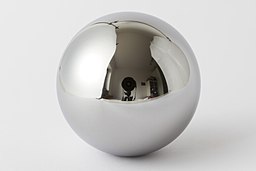Article Revised August 19th, 2022
Metal fabrication is often discussed from the perspective of cutting or forming of material — primary metal fab processes. This shaping generally involves subtracting large amounts of metal or using extreme force to change the shape of the metal without breaking it. However, there is an entire range of processes that don’t get the attention they deserve, and these fall under the category of subtractive metal finishing. Without subtractive finishing — which smooths out the metal’s surface — there would be no way to achieve an acceptable end result that is deliverable to the customer.
What are the three main types of subtractive metal finishing performed at EVS?
At EVS, polishing, buffing, and graining are the primary categories of non-additive metal finishing. While these sound similar and do have things in common, they are technically different processes. Metal graining and metal polishing involve using an abrasive glued to a work wheel or belt; graining is more abrasive than polishing. On the other hand, buffing requires a loose abrasive that is applied rather than adhered to the wheel. While graining and polishing are the more aggressive forms of finishing, the end goal is similar for all three in that all are used to achieve a smoother surface. The type of surface varies greatly, however, which is why the three different processes are all necessary; in fact, there are times when graining, polishing, and buffing are all required to finish a single item.
How do metal graining and polishing work?
While still subtractive metalworking processes, the goal of both isn’t to remove large amounts of material. Instead, the idea is to remove just enough to create a smoother surface, the definition of which depends on the item being finished. This doesn’t usually mean a smooth surface as defined by laymen — it has more to do with surface uniformity. The condition of the metal when it begins to undergo polishing determines what kind of abrasive will be necessary to create the desired surface. A metal surface that has only been polished with a coarser abrasive may not look polished at all to the average eye, as these initial rounds of polishing often leave multiple shallow scratches and marks on the metal. However, as the process continues, finer abrasives are utilized until any marks are invisible without a magnifying instrument.
What are the different types of metal polishing finishes?
In general, most metal finishing processes begin with a rougher (graining) grit to remove larger imperfections such as deep scratches. If a polished finish isn’t desired, the process can stop once a uniform (but still quite rough) surface has been achieved. This is referred to as a #3-grain finish, and it is the result of using a grit between 60 and 120. However, polishing finishes become necessary if the goal is a smoother surface than a #3. Polishing finishes include:
- #4 Architectural Finish (sometimes referred to as a Brushed, Directional, or Satin Finish): Polishing grit lines are uniform and directional in appearance and produced on metal by using a 120-180 grit belt or wheel.
- #4 Dairy or Sanitary Finish: Often utilized by the medical and food industry, primarily on stainless steel. This finish is important for these sectors as it ensures that material defects, such as pits, are removed, decreasing the risk of bacterial growth and contamination. #4 is achieved by polishing with a 180 – 240 grit belt.
- #6 Finish (Satin and Long Grain/Hairline): A fine-grain polish produced via a 240-320 grit belt. Hairline polishes receive an additional process that gives the metal the appearance of long grains that run the length of the material.
Once polishing has been completed, some products move on to the buffing stage, especially if they require a shinier, more reflective finish.
Looking for precision sheet metal fabrication and machining services?
What types of buffing processes are performed at EVS Metal?
Marcin Wichary, CC BY 2.0, via Wikimedia Commons
Buffing is actually comprised of two different processes, called “cut” and “color” motion, respectively. The former creates a uniform surface area by moving the object against the buffing wheel’s or belt’s rotation, while the latter is what gives finished pieces their shine by doing the opposite. There are two types of buffing finishes, #7 and #8:
- #7 Finish (Pre-buff): A smooth finish with light haze and a very bright appearance. Belt polishing is completed with a 280-320 grit before the part undergoes buffing with a cut and color compound.
- #8 Mirror Finish: A very bright finish with at most, a very light haze, and often no visible haze at all. Every surface defect must be removed via polishing before primary buffing and color buffing to achieve this type of finish, but at times, very small grit lines may still be seen at certain angles. Not every metal can be mirror finished — low-quality metals are difficult to impossible to finish in this manner.
- #8 Super Mirror Finish (also referred to as Non-Directional Mirror): Produces a completely grit-free surface by utilizing circular, oscillating buffing with a rouge-like compound.
At EVS, we have the technology and tools to achieve any desired metal finish, from #3 graining to #8 mirror. Ready to discover how our precision finishing processes can add value to your manufacturing supply chain now? Simply request a quote online, or give us a call at (973) 839-4432 today.






